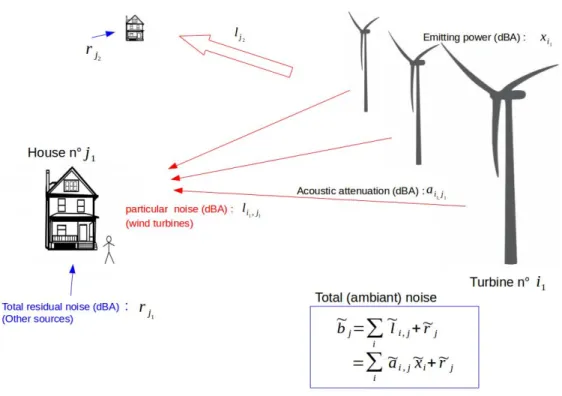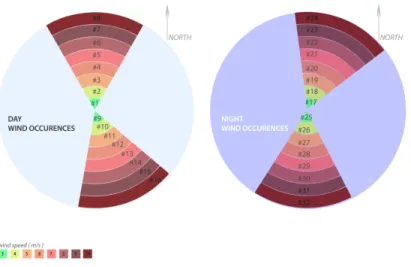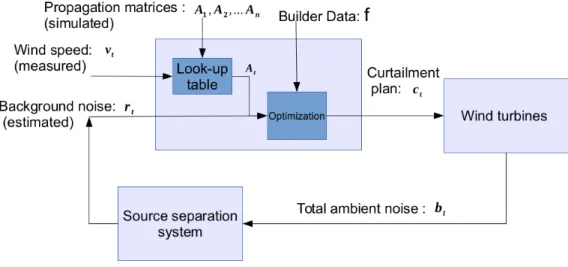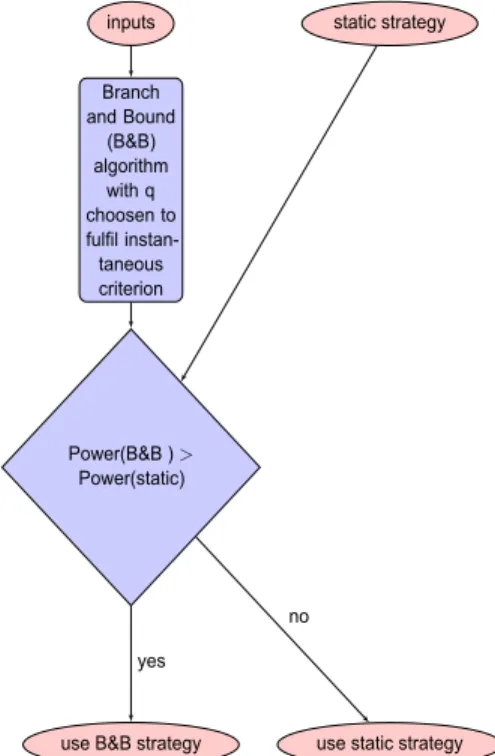HAL Id: hal-01233730
https://hal.inria.fr/hal-01233730
Submitted on 25 Nov 2015
HAL is a multi-disciplinary open access
archive for the deposit and dissemination of
sci-entific research documents, whether they are
pub-lished or not. The documents may come from
teaching and research institutions in France or
abroad, or from public or private research centers.
L’archive ouverte pluridisciplinaire HAL, est
destinée au dépôt et à la diffusion de documents
scientifiques de niveau recherche, publiés ou non,
émanant des établissements d’enseignement et de
recherche français ou étrangers, des laboratoires
publics ou privés.
Acoustic control of wind farms
Baldwin Dumortier, Emmanuel Vincent, Madalina Deaconu
To cite this version:
Baldwin Dumortier, Emmanuel Vincent, Madalina Deaconu. Acoustic control of wind farms. Ewea
2015 - The European Wind Energy Association Conference, Nov 2015, Paris, France. �hal-01233730�
Acoustic Control of Wind Farms
Baldwin Dumortier
1,2,3, Emmanuel Vincent
1,2,3, Madalina Deaconu
1,41Inria, Villers-lès-Nancy, F-54600, France
2CNRS, LORIA, UMR 7503, Villers-lès-Nancy, F-54600, France
3Université de Lorraine, LORIA, UMR 7503, Villers-lès-Nancy, F-54600, France 4Université de Lorraine, CNRS, Institut Elie Cartan de Lorraine - UMR 7502,
Vandœuvre-lès-Nancy, F-54506, France
Abstract
Finer acoustic control of wind farms has be-come essential both to optimise electric produc-tion and ensure inhabitant tranquillity regard-ing the legal acoustic criteria. Current curtail-ment strategies are based on acoustic mea-surements done on short periods of time and online control is based on wind parameters only. This leads both to economic losses and acoustic discomfort. For those reasons, we present a new approach to control wind farms with a control model based on real-time source separation. We use a source separation sys-tem to provide estimates of the noise level im-puted to the wind turbines and the noise level imputed to the other sound sources. Our work focuses on designing a control model. We have proposed a first algorithm that was tested on real data and that will be ground tested soon (2016). The control model is based on a look-up table and on a discrete optimisation algo-rithm to compute curtailment plans. For the vali-dation part, we experimented our control model on the data provided by three acoustic mea-surement campaigns. The results show that an electric gain is always possible without any acoustic degradation compared to the current strategies.
Key words - acoustic annoyance, non linear
discrete optimisation, branch and bound algo-rithm, audio source separation.
1
Introduction
For the past few years, preventing people liv-ing around wind farms from noise pollution has been one of the main concerns of numerous countries around the world.
All countries that pay attention to acoustic an-noyance use either the total ambient noise level or a criterion called acoustical emergence to measure the acoustic annoyance and impose maximal admissible values. However, the cur-rent curtailment strategies slightly differ from one country to another. In this article, we compare our system to the current curtailment acoustic strategy in France. It should be noted however that the algorithm can be adapted for any country. The acoustic emergence is funda-mentally the acoustic energy gain brought by the wind turbines to the background noise per-ceived near housings around the farms. The acoustic control is difficult since the ambient noise level and emergence rapidly evolve with weather and noise conditions.
Currently, pre-studies are made to establish the curtailment plan that must be set in the wind farm control system (SCADA). They con-sist in 2 week measurement campaigns where the wind turbines are periodically turned off. The process however induces high uncertain-ties which are handled by considering worst case scenarios. This leads to great economic losses since the electric production is highly correlated to the noise emission.
For that reason, a finer, real-time control of the noise pollution is required to optimise the
eco-nomic gain. To address this, VENATHEC SAS (France) have imagined and developed a new control system called iEAR based on real-time acoustic measurements and source separation. The design of the algorithm has raised chal-lenges in the fields of audio source separation and control. We have focused our work on the control model and we present in this article a first algorithm and the first experiments on that issue.
The control algorithm is based on the manu-facturer's electric and acoustic power curves and on simulated propagation data stored in a look-up table. The instantaneous curtailment plans are computed by solving an optimisation problem every 10 minutes which can be writ-ten as a convex non linear discrete program-ming problem [1, 2, 3] or equivalently a
non-linear knapsack problem [4, 5]. We
devel-oped our own adapted branch and bound al-gorithm [6, 7] to solve this problem. Branch and bound algorithms are indeed commonly used to solve that type of problems along with outer-approximation [8], generalized benders decomposition [9], extended cutting plane [10], LP/NLP based Branch-and-Bound [11] and hy-brid algorithms.
The general control problem is described in Section 2. The proposed model is then pre-sented in Section 3 and the experiments in Sec-tion 4. Finally, the conclusion and the perspec-tives are given in Section 5.
2
Control problem
2.1
Acoustic criteria
The goal is to optimise the electric production while ensuring that the acoustic constraints are respected for each housing around the farm. Based on the graphical representation of the acoustic power levels in Figure 1, the acoustic constraints can be formulated as follows:
∀j∈ {1, .., J}, ej <Se,oor bj <Ss,o (1)
whereSe,ois the emergence threshold, andSs,o
is the ambient noise threshold. HereJ denotes
the number of measurement points considered
and j one of these measurement points. bj
stands for the total ambient noise in decibels. ej denotes the emergence which is the
acous-tic power gain in decibels brought by the wind turbines on the environment. It is defined as follows:
ej=bj−rj (2)
where rj is the background level (also called
residual noise level).
2.2
Operating modes
The tool provided to reduce the wind turbines' noise emission is a discrete set of smart operat-ing modes that allows the wind farms owner to lower the acoustic emission at the expense of some economic loss. The instantaneous elec-tric production and the acoustic production of a given wind turbine depend both on the wind speed and on the chosen operating modes. In the following, C = {1, 2, ..., C} denotes the set of integers that represents theC operating modes available for the wind turbines on a farm. The operating mode of each wind turbine can be chosen independently. We also usefvto
de-note the concave function that gives the electric power from the acoustic power expressed on a linear scale (W/m2) for a given wind speedv. This notation is used in the description of the optimisation problem in Section 3.1.
2.3
Scientific challenge and
cur-rent strategy
The inherent difficulty about acoustic control of wind farms is that the acoustic emergence and the ambient noise depend both on the residual noise level (i.e, the acoustic noise power due to other sources than wind turbines) and on the particular noise level (i.e, the noise power due to the wind turbines). This double dependency makes the acoustic control challenging:
• The residual noise around a residen-tial area strongly varies over time, even within a single day. Yet, it is not possible to measure the residual noise directly and
Figure 1: Graphical representation of the acoustic power levels
it is impossible to explain these variations with a physical model.
• The particular noise depends on the cur-rent acoustic emission and on the en-ergy loss due to the acoustic propagation which strongly varies with the weather conditions. Theoretically, they can be both computed easily:
– The current emission can be
com-puted from the current operating modes and measured wind speed given the manufacturer's power curves.
– The propagation energy loss can be
simulated using a physical model with ray tracing but changes quickly with the weather conditions.
In France, two weeks measurement cam-paigns are performed to design the curtail-ment plans. The wind turbines are periodically stopped and the difference between the mea-sured ambient levels (with the turbines on) and
the measured residual noise levels (with the turbines off) gives an estimate of the acousti-cal emergence and allows acoustic engineers to design curtailment plans. In order to cope with the variability of the ambient level and of the acoustic emergence, the measurements are indeed classified by weather conditions and noise conditions (wind speed, wind direction, period of the day, etc.). The emergence and the ambient level are considered constant in each class. Yet, as great variability still exist on the system parameters, worst case scenar-ios are considered in current acoustic studies. Figure 2 gives an example of 32 homogeneous classes based on wind speed, angular sectors of wind directions, and period of the day.
Because of this process, the legal criterion in France was slightly modified and the acoustic constraints are then written as follows:
Figure 2: Example of partition of the state parameters into 32 homogeneous classes.
∀o∈ O,∀j∈ {1, ..., J},
mediano(bj)−mediano(rj) <Se,o (3)
or mediano(bj) <Ss,o
where O denotes the set of homogeneous classes ando is one homogeneous class. This criterion uses the median of the measurements in each homogeneous class to take the remain-ing variability into account. This approximation was also developed as it is impossible to mea-sure the emergence directly and curtailment plans are computed with that criterion.
However, the current process is too coarse: • The measurement campaign is
represen-tative of the noise environment for a short period of time. In practice, the noise en-vironment evolves over the course of the year. For instance, the residual noise is usually higher in summer than in winter. • Moreover, even during the
measure-ment campaign, the residual noise level present a high variability.
These last two reasons induce economic losses as worst case scenarios are considered.
3
Proposed model
The control of the particular noise level can be handled by a physical model. We chose to use the manufacturer's power curves and sim-ulated propagation data stored in a look-up ta-ble. However, the measurement and the vari-ability of the residual noise level require the de-sign of a new control system. Because of the novelty of this field of research, we decided to design first an instantaneous and
determinis-tic model based on the approximation usually
made for the problem of allocating acoustic op-erating modes.
The first control algorithm we designed is based on the following hypotheses:
• We considered no lack of reactivity of the wind turbines.
• We considered no uncertainties on the simulation data.
• For the calculations, we developed the al-gorithm to optimise the electric power un-der any maximal value of instantaneous particular noise. This allows us to fulfil the instantaneous emergence (equation 1) or even the median criteria used in France (equation 3) with a specific con-trol method.
Figure 3: General operation scheme of the instantaneous and deterministic system
Figure 3 gives the general operation scheme of the first model.
The wind speed and the wind direction mea-sured at the turbine hub and the residual power estimated by the source separation system are the input data. From the wind data, the corre-sponding acoustic power attenuation matrix is retrieved and the optimisation is then computed with the power curves to build the curtailment strategy to be applied for the next 10 minutes.
3.1
Optimisation problem
We have shown that the deterministic and in-stantaneous assumptions allow us to write the problem as a non linear convex discrete pro-gramming problem or equivalently as a nonlin-ear knapsack problem [12, 4]:
max˜x∈(˜x(C)I∑i=1I fv(˜xi) ˜ AT˜x≤q (4)
where I is the number of wind turbines, ˜x is theI×1 vector of emission power of the wind turbines of the farms and whose values are chosen in the discrete set of acoustic emission power denoted by˜x(C)I. fvis the function that
gives the instantaneous electric production and ˜
AT is the matrix of acoustic power attenuation due to propagation. q is the J×1 vector that specifies maximal admissible values of particu-lar noise at each measurement pointj.
Note that this formulation is very general and our algorithm can optimise the instantaneous electric production under any maximal admissi-ble values of particular noise.
We solved the problem with an adapted branch and bound algorithm. Branch and bound al-gorithms are optimisation methods based on a tree structure to represent the admissible1 so-lutions and on a browse them efficiently using the "divide an conquer principle". Each node is labelled with an upper bound of the objec-tive function. A each iteration, a new solution is found thanks to the value of the former solu-tion. To illustrate the principle, Figure 4 gives an intuitive example of one iteration of the
veloped algorithm:
• We suppose that we already have a solu-tion achieving a power of 2000 kW at the beginning of the iteration.
• Usually a step is done simply by taking the following node.
• When a node with a lower bound is browsed, the current branch is erased and the algorithm backtracks as it is point-less to browse it. Indeed, we are sure that it is not possible to find a better solution than the one we already have among the leaves it leads to.
• When a new leaf of the tree is reached, we obtain a new solution with a better ob-jective value (2100 kW here). The algo-rithm finishes when all the branches have been either browsed or erased.
Note that the bound of each node is obtained by solving a continuous relaxation problem solved with an adapted gradient algorithm.
We also initialise our algorithm with the solution obtained from a greedy heuristic inspired by an algorithm used in the field of acoustics to accel-erate convergence to the optimal solution.
3.2
Handling the median criterion
The proposed algorithm can optimise under any maximal admissible values (see Section 3.1), and one could choose to limit the instanta-neous acoustic criterion at each time. However, in the studied cases, the curtailment plans were computed from medians of the particular and residual noise over time. For that reason, it ap-pears that fulfilling the instantaneous criterion (equation 1) may induce economic gain loss in some cases (see 4). To remedy this, we had to adapt the instantaneous algorithm in order to fulfil the median emergence criteria used in France by comparing the obtained result with the static strategy, i.e the curtailment plans cur-rently used on the wind farm. Figure 5 illus-trates the algorithm used eventually. This adap-tation allows the criterion employed in Franceto be fulfilled with a consistent economic gain compared to the static strategy (see Section 4).
. . inputs. Branch and Bound (B&B) algorithm with q choosen to fulfil instan-taneous criterion . static strategy . Power(B&B )> Power(static) .
use B&B strategy .
use static strategy .
yes .
no
Figure 5: General scheme of the optimisation unit handling the median criterion (equation 3.
4
Experiments and results
We tested our algorithm on real data from 3 different wind farms using field measurements for the residual acoustic levels, acoustic simu-lations for the propagation data, and the man-ufacturer's curves. The algorithm is to be field tested before the end of next year (2016). We experimentally verified that the branch and bound algorithm yields most of the time the optimal result (98,5% of the 1210 test cases). Then, we simulated the acoustical control with the acoustical data coming from 3 wind farms. The detailed results are given in Figures 6 and 7.
Figure 4: Example of iteration for the branch and bound algorithm for a starting solution of 2000 kW.
Production loss (%) wind farm 1 wind farm 2 wind farm 3 compared to full-power day night day night day night Full-power Strategy 0 0 0 0 0 0
Static strategy 2.2 42.4 0 63.6 0 0 Instantaneous criterion control 9.2 34.4 3.8 56.3 0 1.2
Median criterion control 1.4 30.7 0 53.6 0 0
Figure 6: Production losses compared to full-power operation
Acoustic excesses wind farm 1 wind farm 2 wind farm 3 (% of time) day night day night day night Full-power strategy 39 91 1 100 0 1
Static strategy 30 33 1 31 0 1 Instantaneous criterion control 0 4 0 1 0 0 Median criterion control 30 31 1 31 0 1
Figure 7: Proportion of acoustic excesses over time (in percent of the full duration)
5
Conclusions
In this article, we presented a new system for acoustic control based on source separa-tion. Specifically, we have presented a control
method that appears both easy to implement and that can be adapted to specific law of each country. The economic gain of such a system depends on the law governing the usual curtail-ment plan design. in the French case, special precautions must be taken to ensure a system-atic economic gain.
In the future we will seek to refine with more general hypothesis:
• Concerning the wind turbine reactivity, our approximation is acceptable since the reactivity related to switching from an op-erating mode to another is often very small. In particular, this is verified for the wind turbines that will be used for field testing. However, a more general prob-lem can be formulated using short-term wind predictions [13] and dynamic pro-gramming [14].
• The particular noise is an acceptable model for the power curves and the prop-agation models are based on worst case scenarios. However, recalibration of the acoustic power curves/propagation data
and the remaining uncertainties will be considered. Note also that power curve estimation methods may be used instead of manufacturer's power curves to im-prove accuracy. On that matter, several power curve estimation methods were re-cently compared by Lydia and al [15] and by Schlechtingen and al [16].
Acknowledgment
This work was done thanks to the support of Venathec SAS, CPER MISN TALC and region Lorraine.
References
[1] Claudia D’Ambrosio and Andrea Lodi. Mixed integer nonlinear programming tools: a practical overview. 4OR, 9(4):329--349, 2011.
[2] Pierre Bonami, Mustafa Kilinç, and Jeff Linderoth. Algorithms and software for convex mixed integer nonlinear programs. In Mixed integer nonlinear programming, pages 1--39. Springer, 2012.
[3] Samuel Burer and Adam N. Letchford. Non-convex mixed-integer nonlinear pro-gramming: a survey. Surveys in Op-erations Research and Management Sci-ence, 17(2):97--106, 2012.
[4] Dorit S. Hochbaum. A nonlinear knapsack problem. Operations Research Letters, 17(3):103--110, 1995.
[5] Kamlesh Mathur, Harvey M Salkin, and Susumu Morito. A branch and search al-gorithm for a class of nonlinear knapsack problems. Operations Research Letters, 2(4):155--160, 1983.
[6] Michel Sakarovitch. Optimisation
com-binatoire: Programmation discrète,
vol-ume 2. Editions Hermann, 1984.
[7] Jacques Teghem. La recherche
opérationnelle tome 1: Les méthodes d'optimisation. 2012.
[8] Marco A Duran and Ignacio E Gross-mann. An outer-approximation algorithm for a class of mixed-integer nonlinear programs. Mathematical programming, 36(3):307--339, 1986.
[9] Arthur M Geoffrion. Generalized benders decomposition. Journal of optimization theory and applications, 10(4):237--260, 1972.
[10] Tapio Westerlund and Frank Pettersson. An extended cutting plane method for solv-ing convex minlp problems. Comput-ers & Chemical Engineering, 19:131--136, 1995.
[11] Ignacio Quesada and Ignacio E Gross-mann. An lp/nlp based branch and bound algorithm for convex minlp optimization problems. Computers & chemical engi-neering, 16(10):937--947, 1992.
[12] Stephen Boyd and Lieven Vandenberghe. Convex optimization. Cambridge univer-sity press, 2009.
[13] Gregor Giebel, Richard Brownsword, George Kariniotakis, Michael Denhard, and Caroline Draxl. The state-of-the-art in short-term prediction of wind power: A literature overview. Technical report, ANEMOS. plus, 2011.
[14] Dimitri P. Bertsekas. Dynamic Program-ming: Deterministic and Stochastic Mod-els. Academic Press, 1976.
[15] M. Lydia, Sahoo Subhendu Kumar, G. Ed-win Prem Kumar, and A. Immanuel Sel-vakumar. Advanced algorithms for wind turbine power curve modeling. Sus-tainable Energy, IEEE Transactions on, 4(3):827--835, 2013.
[16] Meik Schlechtingen, Ilmar Ferreira San-tos, and Sofiane Achiche. Using data-mining approaches for wind turbine power curve monitoring: a comparative study. Sustainable Energy, IEEE Transactions on, 4(3):671--679, 2013.




